Tesla continues to capture investor attention as Wall Street weighs its ambitious projects against current market realities. With shares trading at notable highs, discussion has intensified around the company’s future in robotics and vehicle autonomy. Some market participants express skepticism regarding the valuation, while others focus on Tesla’s evolving technological ventures and their potential impact. Expectations remain high, yet the path forward is still full of uncertainties as competitors increase pressure and market narratives shift quickly.
Several months ago, analysts and media sources highlighted Tesla’s heavy reliance on storyline-driven momentum rather than traditional financial benchmarks. Reports mentioned Tesla’s perceived resilience but also cautioned about rising competition, especially in the autonomous driving sector from firms in China and the United States. The Optimus robotics project was described as ambitious but still in early development stages, with previous estimates of its commercial timeline extending well beyond 2024. Around that time, price targets from major banks often lagged behind Tesla’s share price, a pattern that persists as optimism about future technology remains counterbalanced by skepticism over timelines and execution.
What Drives Goldman Sachs’ Updated Target?
Goldman Sachs analyst Mark Delaney increased Tesla’s price target from $300 to $395, even though the stock trades above the new target range at $420-$430. His assessment points to Tesla’s growth prospects if it achieves significant advances in both humanoid robots and autonomous vehicles. Delaney explained,
“If Tesla can have [an] outsized share in areas such as humanoid robotics and autonomy, then there could be upside to our price target.”
The analyst also cautioned that performance in these areas is not guaranteed to drive share price higher.
Are Robotics and Autonomy Enough to Sustain Valuation?
Tesla has invested considerable resources into its Optimus humanoid robot project, which has shown progress with successive prototypes. The company is also advancing its Full Self-Driving (FSD) suite and expanding robotaxi operations, particularly in Austin and the Bay Area. These initiatives seek to reinforce Tesla’s position in automation, though they require ongoing development and broad regulatory acceptance before achieving mass-market impact. Performance in competitive spaces like advanced driver-assistance systems (ADAS) in various global markets remains critical for future growth.
What Risks Could Complicate Tesla’s Trajectory?
Despite its technological headway, Tesla faces risks from escalating competition and the challenge of scaling complex innovations reliably. Delaney noted the potential downsides, stating,
“…although if competition limits profits (as is happening with the ADAS market in China) or Tesla does not execute well, then there could be downside.”
The balance between growth aspirations and real-world execution continues to shape analysts’ cautious approach. Unexpected market shifts and regulatory developments could further affect the company’s valuation outlook.
The company’s ongoing efforts in robotics and autonomy highlight its dual strategy of leveraging both hardware and software advancements. While investor enthusiasm around projects like Optimus and the FSD suite provides upside potential, these initiatives also come with long development cycles and execution risk. Traders should pay attention to tangible milestones—such as regulatory approvals, deployment expansion of robotaxis, and continued public updates on Optimus progress—to better assess the real momentum behind Tesla’s story. Considering the dynamic and sometimes speculative atmosphere surrounding the stock, critical analysis remains key. Those tracking Tesla’s trajectory may find the recent price target revision reflective not just of optimism, but also of the challenges associated with leading high-tech innovation in a rapidly evolving industry.










